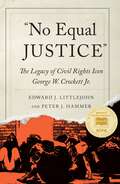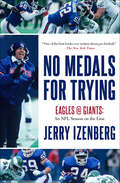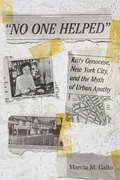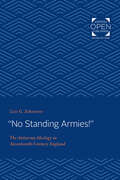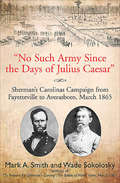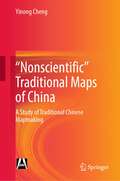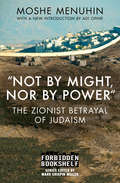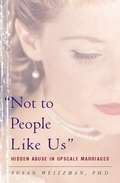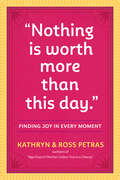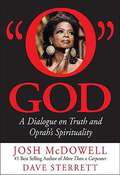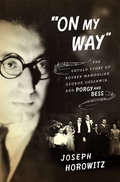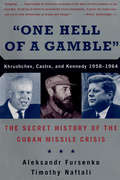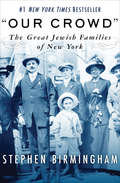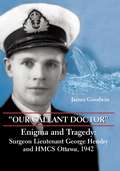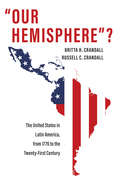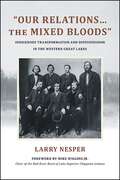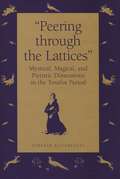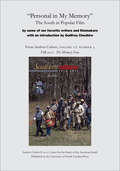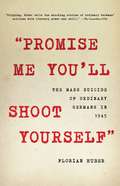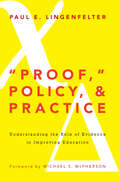- Table View
- List View
"No Equal Justice": The Legacy of Civil Rights Icon George W. Crockett Jr. (African American Life Series)
by Peter J. Hammer Edward J. Littlejohn"There is no equal justice for Black people today; there never has been. To our everlasting shame, the quality of justice in America has always been and is now directly related to the color of one’s skin as well as to the size of one’s pocketbook." This quote comes from George W. Crockett Jr.’s essay, "A Black Judge Speaks" (Judicature, 1970). The stories of Black lawyers and judges are rarely told. By sharing Crockett’s life of principled courage, "No Equal Justice" breaks this silence. The book begins by tracing the Crockett family history from slavery to George’s admission into the University of Michigan Law School. He became one of the most senior Black lawyers in President Franklin Roosevelt’s New Deal administration. Later, he played a central role fighting discrimination in the United Auto Workers union. In 1949, he became the only Black lawyer, in a team of five attorneys, defending the constitutional rights of the leaders of the U.S. Communist Party in United States v. Dennis, the longest and most dramatic political trial in American history. At the close of the case, Crockett and his defense colleagues were summarily sentenced to prison for zealously representing their clients. He headed the National Lawyers Guild office in Jackson, Mississippi, during 1964’s Freedom Summer. In 1966, he was elected to Detroit’s Recorder’s Court—the court hearing all criminal cases in the city. For the first time, Detroit had a courtroom where Black litigants knew they would be treated fairly. In 1969, the New Bethel Church Incident was Crockett’s most famous case. He held court proceeding in the police station itself, freeing members of a Black nationalist group who had been illegally arrested. In 1980, he was elected to the United States Congress where he spent a decade fighting President Reagan’s agenda, as well as working to end Apartheid in South Africa and championing the cause to free Nelson Mandela. Crockett spent his life fighting racism and defending the constitutional rights of the oppressed. This book introduces him to a new generation of readers, historians, and social justice activists.
"No Medals for Trying": Eagles @ Giants: An NFL Season on the Line
by Jerry IzenbergThe legendary sportswriter &“details the grit of the gladiators and the psyche of the coaches . . . One of the best books ever written about pro football&” (The New York Times). Monday, November 27, 1989. After a ten-point loss to the San Francisco 49ers, the New York Giants return home. Thirty-four-year-old quarterback Phil Simms has reinjured his ankle. Linebacker Lawrence Taylor, the guts of the defense, is in great pain, supported by crutches. And while the players, coaches, and trainers are still lost in thoughts of what might have been, the next game looms large in front of them: a now must-win battle against their division rivals, the Philadelphia Eagles. What follows is an intense, hour-by-hour account of a team pushed to the brink. Sportswriter Jerry Izenberg, granted unprecedented access, chronicles the tremendous physical and emotional strain experienced by both those on the frontlines and behind-the-scenes—the embattled superstars, workhorses, defensive and offensive staffs, and equipment managers. Izenberg shadows head coach Bill Parcells as he struggles to rally his team and draw up a game plan without his clutch players. He puts readers in the maelstrom of stress, uncertainty, and grim determination that permeate the locker room as the players face a team that has beaten them three time in a row—in a game that will decide the division. It&’s all here as &“Izenberg builds the suspense so masterfully that grid aficionados will be caught up in the story&” (Publishers Weekly). &“Izenberg&’s hour-by-hour account of the painstaking preparations will open the eyes of even the most knowledgeable fan.&” —The Buffalo News &“The book is a treat for football fans.&” —The Baltimore Sun
"No One Helped": Kitty Genovese, New York City, and the Myth of Urban Apathy
by Marcia M. GalloIn "No One Helped" Marcia M. Gallo examines one of America's most infamous true-crime stories: the 1964 rape and murder of Catherine "Kitty" Genovese in a middle-class neighborhood of Queens, New York. Front-page reports in the New York Times incorrectly identified thirty-eight indifferent witnesses to the crime, fueling fears of apathy and urban decay. Genovese's life, including her lesbian relationship, also was obscured in media accounts of the crime. Fifty years later, the story of Kitty Genovese continues to circulate in popular culture. Although it is now widely known that there were far fewer actual witnesses to the crime than was reported in 1964, the moral of the story continues to be urban apathy. "No One Helped" traces the Genovese story's development and resilience while challenging the myth it created. "No One Helped" places the conscious creation and promotion of the Genovese story within a changing urban environment. Gallo reviews New York's shifting racial and economic demographics and explores post-World War II examinations of conscience regarding the horrors of Nazism. These were important factors in the uncritical acceptance of the story by most media, political leaders, and the public despite repeated protests from Genovese's Kew Gardens neighbors at their inaccurate portrayal. The crime led to advances in criminal justice and psychology, such as the development of the 911 emergency system and numerous studies of bystander behaviors. Gallo emphasizes that the response to the crime also led to increased community organizing as well as feminist campaigns against sexual violence. Even though the particulars of the sad story of her death were distorted, Kitty Genovese left an enduring legacy of positive changes to the urban environment.
"No Standing Armies!": The Antiarmy Ideology in Seventeenth-Century England
by Lois G. SchwoererOriginally published in 1974. In her study of primary materials in England and the United States, Schwoerer traces the origin, development, and articulation in both Parliament and in the popular press of the attitude opposing standing armies in seventeenth-century England and the American colonies. Central to the criticism of armies at that time was the conviction that ultimate military power should be vested in Parliament, not the Crown. Schwoerer shows how the many diverse elements of England's antimilitarism, including political principle, propaganda, parliamentary tactics, parochialism, and partisanship, hardened with every confrontation between the Crown or Protector and Parliament. The author finds a general predisposition to distrust professional soldiers early in the century, and from the 1620s onward she notes opposition to a standing army in times of peace. Highlighting the growth of the antimilitary tradition, Schwoerer traces the development of this attitude from the Petition of Right in 1628 to the 1641–1642 crisis over the Militia Bill/Ordinance, the military settlements of 1660 and 1689, and the climactic events of 1667–1699. Schwoerer shows how the anti-standing-army ideology affected the constitutional thinking of the American colonists and manifested itself in the Constitution and the Bill of Rights. She addresses timeless questions of how to provide for a nation's defense while preserving individual liberty, citizen responsibility for military service, and the relationship of executive and legislative authority over the army.
"No Such Army Since the Days of Julius Caesar": Sherman's Carolinas Campaign from Fayetteville to Averasboro, March 1865
by Mark A. Smith Wade SokoloskyGeneral William T. Shermans 1865 Carolinas Campaign receives scant attention from most Civil War historians, largely because it was overshadowed by the Army of Northern Virginias final battles against the Army of the Potomac. Career military officers Mark A. Smith and Wade Sokolosky rectify this oversight with No Such Army Since the Days of Julius Caesar, a careful and impartial examination of Shermans army and its many accomplishments.The authors dedicate their professional training and research and writing abilities to the critical days of March 11-16, 1865the overlooked run-up to the seminal Battle of Bentonville (March 19-21, 1865). They begin with the capture of Fayetteville and the demolition of the arsenal there, before chronicling the two-day Battle of Averasboro in more detail than any other study. At Averasboro, Lt. Gen. William J. Hardees Confederates conducted a well-planned and brilliantly executed defense-in-depth that held Shermans juggernaut in check for two days. With his objective accomplished, Hardee disengaged and marched to concentrate his corps with Gen. Joseph E. Johnston for what would become Bentonville.This completely revised and updated edition of No Such Army Since the Days of Julius Caesar: Shermans Carolinas Campaign from Fayetteville to Averasboro, March 1865 is based upon extensive archival and firsthand research. It includes new original maps, orders of battle, abundant illustrations, and a detailed driving and walking tour for dedicated battlefield enthusiasts. Readers with an interest in the Carolinas, Generals Sherman and Johnston, or the Civil War in general will enjoy this book.
"Nonscientific” Traditional Maps of China: A Study of Traditional Chinese Mapmaking
by Yinong ChengThis book analyzes the drawing data and methods of the Chinese ancient maps that are neglected by the previous researches, and reevaluates the drawing theories and methods, the influences, and accuracy of the maps that represents the scientificity of Chinese ancient cartographic drawings.
"Not by Might, Nor by Power": The Zionist Betrayal of Judaism (Forbidden Bookshelf #22)
by Moshe MenuhinWith a new introduction by Adi Ophir: An early and fierce critique of Zionism from a Jewish child of Palestine who argued against nationalism and injustice. Born in 1893, Moshe Menuhin was part of the inaugural class to attend the first Zionist high school in Palestine, the Herzliya gymnasium in Tel Aviv. He had grown up in a Hasidic home, but eventually rejected orthodoxy while remaining dedicated to Judaism. As a witness to the evolution of Israel, Menuhin grew disaffected with what he saw as a betrayal of the Jews&’ spiritual principles. This memoir, written in 1965, is considered the first revisionist history of Zionism. A groundbreaking document, it discusses the treatment of the Palestinians, the effects of the Holocaust, the exploitation of the Mizrahi Jewish immigrants, and the use of propaganda to win over public opinion in America and among American Jews. In a postscript added after the Six-Day War, Menuhin also addresses the question of occupation. This new edition is updated with an introduction by Israeli philosopher Adi Ophir, putting Menuhin&’s work into a contemporary historical context. Passionate and sometimes inflammatory in its prose, and met with controversy and anger upon its original publication under the title The Decadence of Judaism in Our Time, Menuhin&’s polemic remains both a thought-provoking reassessment of Zionist history and a fascinating look at one observer&’s experience of this embattled corner of the world over the course of several tumultuous decades.
"Not so fast..." Litigation Strategy in EMC Corporation v. Donatelli (B)
by Lena G. Goldberg Danielle V. HollandSupplement
"Not to People Like Us": Hidden Abuse in Upscale Marriages
by Susan WeitzmanHow is it possible for a highly educated woman with a career and resources of her own to stay in a marriage with an abusive husband? How can a man be considered a pillar of his community and regularly give his wife a black eye? The very nature of these questions proves how convinced we are that domestic violence is restricted to the lower classes. Now Susan Weitzman explores a heretofore overlooked population of battered wives-the upper-educated and upper-income women who rarely report abuse and remain trapped by their own silence.
"Nothing Is Worth More Than This Day.": Finding Joy in Every Moment
by Ross Petras Kathryn PetrasA book of inspirational quotations, Nothing Is Worth More Than This Day presents hundreds of reminders from some of the smartest people who ever lived—from Dr. Seuss to Erma Bombeck, Thich Nhat Hanh to Lena Dunham—that happiness is everywhere and the glass is half-full. It’s the perfect gift of optimism, for good times and not-so-good times.
"O" God: A Dialogue On Truth And Oprah's Spirituality
by Josh Mcdowell Dave Sterrett"O" God: A Dialogue on Truth and Oprah's Spirituality provides an in-depth look at one of the greatest media influences of all time: the empire of Oprah. Between The Oprah Winfrey Show and O Magazine, millions of people are exposed to Oprah's spiritual beliefs. Christians and those of other faiths are asking tough questions and looking for answers. McDowell and Sterrett approach the spirituality of Oprah by means of a fictional narrative featuring conversation between two friends. The spiritual conversation begins when the two girls get together to discuss spiritual issues. By using stories to address the deeper issues raised in the spiritual discussions held by Oprah and her friends, McDowell and Sterrett disarm and entertain their readers while also revealing biblical truths and exposing the errant teachings and misconceptions of Oprah. Meredith Andrews explains that: "In a day and time when some people feel that truth becomes obscure and moral lines are blurry, 'O' God addresses the popular concept of tolerance, along with other controversial ideas embraced and taught by Oprah herself, in a way that is easily accessible, scripturally based, and lovingly communicated. McDowell and Sterrett do a phenomenal job of comparing and contrasting Oprah's spiritual undertakings with God's Word and helping readers to thoroughly examine the spiritual trends of the day. Completely eye-opening and a must-read." McDowell, a mega-bestselling Christian author and evangelist, teams up with Sterrett, a gifted writer and popular speaker, to broach a serious subject with a wise, balanced, easy-to-read approach. McDowell and Sterrett help readers to discern the truth about the spirituality of Oprah and her friends.
"Old Slow Town": Detroit During the Civil War
by Paul TaylorThough it was located far away from Southern battlefields, Detroit churned with unrest during the American Civil War. The city's population, including a large German and Irish immigrant community, mostly aligned with anti-war Democrats while the rest of the state stood with the pro-Lincoln Republicans. The virulently anti-Lincoln and anti-Black Detroit Free Press fanned the city's flames with provocative coverage of events. In "Old Slow Town": Detroit during the Civil War, award-winning author Paul Taylor contends that the anger within Detroit's diverse political and ethnic communities over questions about the war's purpose and its conduct nearly tore the city in two. Taylor charts Civil War-era Detroit's evolution from a quiet but growing industrial city (derisively called "old slow town" by some visitors) to a center of political contention and controversy. In eight chapters, Taylor details topics including the pre-war ethnic and commercial development of the city; fear and suspicion of "secret societies"; issues of race, gender, and economic strife during the war; Detroit's response to its soldiers' needs; and celebration and remembrance at the conclusion of the conflict. Taylor's use of rarely seen military correspondence from the National Archives, soldier and civilian diaries and letters, period articles and editorials from Detroit's Civil War-era newspapers, and his fresh, judicious synthesis of secondary sources results in a captivating depiction of Detroit's Civil War history. Until now, why events occurred as they did in Detroit during the Civil War and what life was like for its residents has only been touched upon in any number of general histories. Readers interested in American history, Civil War history, or the ethnic history of Detroit will appreciate the full picture of the time period Taylor presents in "Old Slow Town."
"On My Way": The Untold Story of Rouben Mamoulian, George Gershwin, and Porgy and Bess
by Joseph HorowitzA revelatory history of the operatic masterpiece that both made and destroyed Rouben Mamoulian, its director and unsung hero. "Bring my goat!" Porgy exclaims in the final scene of Gershwin's opera Porgy and Bess. Bess, whom he loves, has left for New York City, and he's determined to find her. When his request is met with astonishment--New York is a great distance from South Carolina's Catfish Row--Porgy remains undaunted. He mounts his goat-cart and leads the community in an ecstatic finale, "Oh Lawd, I'm on my way." Stephen Sondheim has called "Bring my goat!" "one of the most moving moments in musical theater history." For years it was assumed that DuBose Heyward--the author of the seminal novella and subsequent play, Porgy, and later the librettist for the opera Porgy and Bess--penned this historic line. In fact, both it and "Oh Lawd, I'm on my way" were added to the play eight years earlier by that production's unheralded architect: Rouben Mamoulian. Porgy and Bess as we know it would not exist without the contributions of this master director. Culling new information from the recently opened Mamoulian Archives at the Library of Congress, award-winning author Joseph Horowitz shows that, more than anyone else, Mamoulian took Heyward's vignette of a regional African-American subculture and transformed it into an epic theater work, a universal parable of suffering and redemption. Part biography, part revelatory history, "On My Way" re-creates Mamoulian's visionary style on stage and screen, his collaboration with George Gershwin, and the genesis of the opera that changed the face of American musical life.
"One Hell of a Gamble": Krushchev, Castro, and Kennedy, 1958-1964
by Timothy Naftali Aleksandr FursenkoBased on classified Soviet archives, including the files of Nikita Khrushchev and the KGB, "One Hell of a Gamble" offers a riveting play-by-play history of the Cuban missile crisis from American and Soviet perspectives simultaneously. No other book offers this inside look at the strategies of the Soviet leadership. John F. Kennedy did not live to write his memoirs; Fidel Castro will not reveal what he knows; and the records of the Soviet Union have long been sealed from public view: Of the most frightening episode of the Cold War--the Cuban Missile Crisis--we have had an incomplete picture. When did Castro embrace the Soviet Union? What proposals were put before the Kremlin through Kennedy's back-channel diplomacy? How close did we come to nuclear war? These questions have now been answered for the first time. This important and controversial book draws the missing half of the story from secret Soviet archives revealed exclusively by the authors, including the files of Nikita Khrushchev and his leadership circle. Contained in these remarkable documents are the details of over forty secret meetings between Robert Kennedy and his Soviet contact, records of Castro's first solicitation of Soviet favor, and the plans, suspicions, and strategies of Khrushchev. This unique research opportunity has allowed the authors to tell the complete, fascinating, and terrifying story of the most dangerous days of the last half-century.
"Original Sin," Balance Sheet Crises, and the Roles of International Lending
by Olivier Jeanne Jeromin ZettelmeyerA report from the International Monetary Fund.
"Our Crowd": The Great Jewish Families of New York (Modern Jewish History Ser.)
by Stephen BirminghamThe #1 New York Times bestseller that traces the rise of the Guggenheims, the Goldmans, and other families from immigrant poverty to social prominence. They immigrated to America from Germany in the nineteenth century with names like Loeb, Sachs, Seligman, Lehman, Guggenheim, and Goldman. From tenements on the Lower East Side to Park Avenue mansions, this handful of Jewish families turned small businesses into imposing enterprises and amassed spectacular fortunes. But despite possessing breathtaking wealth that rivaled the Astors and Rockefellers, they were barred by the gentile establishment from the lofty realm of &“the 400,&” a register of New York&’s most elite, because of their religion and humble backgrounds. In response, they created their own elite &“100,&” a privileged society as opulent and exclusive as the one that had refused them entry. &“Our Crowd&” is the fascinating story of this rarefied society. Based on letters, documents, diary entries, and intimate personal remembrances of family lore by members of these most illustrious clans, it is an engrossing portrait of upper-class Jewish life over two centuries; a riveting story of the bankers, brokers, financiers, philanthropists, and business tycoons who started with nothing and turned their family names into American institutions.
"Our Gallant Doctor": Surgeon-Lieutenant George Hendry and HMCS Ottawa, 1942
by James GoodwinDuring the Battle of the Atlantic, Dr. George Hendry had just finished performing two major surgical operations on board the destroyer HMCS Ottawa when his ship was ambushed by 13 German U-boats. Canadian warships like Ottawa had inadequate radar sets that were incapable of detecting submarines approaching in the dark. On September 13, 1942, U-91 stole in and torpedoed Ottawa, sinking her in 20 minutes. utterly exhausted, Dr. Hendry was lost along with 113 of his shipmates. George Hendry was a much-loved man, a great university athlete, and a very good doctor. Unfortunately, he was also naive and too trusting. One night in January 1941, he committed a very foolish indiscretion. He would spend the rest of his tragically short life making amends for this mistake.
"Our Hemisphere"?: The United States in Latin America, from 1776 to the Twenty-First Century
by Russell C. Crandall Britta H. CrandallAn accessible exploration of U.S.–Latin American relations. from the colonial period to the present day &“&‘Our Hemisphere&’? is a balanced and nuanced portrayal of the history of U.S.–Latin American relations. The attention given to more recent episodes on immigration, the drug war and U.S. policy toward Cuba and Venezuela, is especially welcome.&”—Allen Wells, author of Tropical Zion: General Trujillo, FDR and the Jews of Sosúa &“Our Hemisphere&”? uncovers the range, depth, and veracity of the United States&’ relationship with the Americas. Using short historical vignettes, Britta and Russell Crandall chart the course of inter‑American relations from 1776 to the present, highlighting the roles that individuals and groups of soldiers, intellectuals, private citizens, and politicians have had in shaping U.S. policy toward Latin America in the postcolonial, Cold War, and post–Cold War eras. The United States is usually and correctly seen as pursuing a monolithic, hegemonic agenda in Latin America, wielding political, economic, and military muscle to force Latin American countries to do its bidding, but the Crandalls reveal unexpected yet salient regional interactions where Latin Americans have exercised their own power with their northern and very powerful neighbor. Moreover, they show that Washington&’s relationship with the region has relied, in addition to the usual heavy‑handedness, on cooperation and mutual respect since the beginning of the relationship.
"Our Relations…the Mixed Bloods": Indigenous Transformation and Dispossession in the Western Great Lakes (SUNY series, Tribal Worlds: Critical Studies in American Indian Nation Building)
by Larry NesperIn the Great Lakes region of the nineteenth century, "mixed bloods" were a class of people living within changing indigenous communities. As such, they were considered in treaties signed between the tribal nations and the federal government. Larry Nesper focuses on the implementation and long-term effects of the mixed-blood provision of the 1854 treaty with the Chippewa of Wisconsin. That treaty not only ceded lands and created the Ojibwe Indian reservations in the region, it also entitled hundreds of "mixed-bloods belonging to the Chippewas of Lake Superior," as they appear in this treaty, to locate parcels of land in the ceded territories. However, quickly dispossessed of their entitlement, the treaty provision effectively capitalized the first mining companies in Wisconsin, initiating the period of non-renewable resource extraction that changed the demography, ecology, and potential future for the region for both natives and non-natives. With the influx of Euro-Americans onto these lands, conflicts over belonging and difference, as well as community leadership, proliferated on these new reservations well into the twentieth century. This book reveals the tensions between emergent racial ideology and the resilience of kinship that shaped the historical trajectory of regional tribal society to the present.
"Peering Through the Lattices": Mystical, Magical, and Pietistic Dimensions in the Tosafist Period
by Ephraim KanarfogelDuring the high Middle Ages, the tosafists flourished in northern Europe and revolutionized the study of the Talmud. These Jewish scholars did not participate in the philosophical and religious thought that concerned Christendom, and today they are seen as having played a limited role in mystical or esoteric studies. Ephraim Kanarfogel now challenges this conventional view of the tosafists, showing that many individuals were influenced by ascetic and pietistic practices and were involved with mystical and magical doctrines. He traces the presence of these disciplines in the pre-Crusade period, shows how they are intertwined, and suggests that the widely available Hekhalot literature was an important conduit for this material. He also demonstrates that the asceticism and esotericism of the German Pietists were an integral part of Ashkenazic rabbinic culture after the failure of Rashbam and other early tosafists to suppress these aspects of pre-Crusade thinking. The identification of these various forms of spirituality places the tosafists among those medieval rabbinic thinkers who sought to supplement their Talmudism with other areas of knowledge such as philosophy and kabbalah, demonstrating the compatibility of rabbinic culture and mysticism. These interests, argues Kanarfogel, explain both references to medieval Ashkenazic rabbinic figures in kabbalistic literature and the acceptance of certain ascetic and mystical practices by later Ashkenazic scholars. Drawing on original manuscript research, Kanarfogel makes available for the first time many passages produced by lesser known tosafists and rabbinic figures and integrates the findings of earlier and contemporary scholarship, much of it published only in Hebrew. "Peering through the Lattices" provides a greater appreciation for these texts and opens up new opportunities for scholarhship in Jewish history and thought.
"Personal in My Memory": The South in Popular Film by some of our favorite writers and filmmakers
by Godfrey CheshirePersonal in My Memory"The South in Popular Filmby some of our favorite writers and filmmakers with an introduction by Godfrey CheshireAlice Walker, Allan Gurganus, Randall Kenan, Joe Flora, Kenneth Turan, Elizabeth Spencer, and Andrew Garrison tell how their favorite Southern films marked them indelibly."We have two imaginary kingdoms. One, 'the South,' exists primarily in song, oral traditions and folkways, native art and literature. The other, 'Hollywood,' creates mass-produced audiovisual entertainments for American and world audiences, and develops its own mythology."
"Pity the Finance Minister": Issues in Managing a Substantial Scaling Up of Aid Flows
by Peter S. HellerA report from the International Monetary Fund.
"Political Shari'a"? Human Rights and Islamic Law in Northern Nigeria
by Human Rights WatchSince 2000, twelve states in northern Nigeria have added criminal law to the jurisdiction of Shari'a (Islamic law) courts. Shari'a has been in force for many years in northern Nigeria, where the majority of the population is Muslim, but until 2000, its scope was limited to personal status and civil law. The manner in which Shari'a has been applied to criminal law in Nigeria so far has raised a number of serious human rights concerns. It has also created much controversy in a country where religious divisions run deep, and where the federal constitution specifies that there is no state religion.
"Promise Me You'll Shoot Yourself": The Mass Suicide of Ordinary Germans in 1945
by Florian HuberNamed a Best History Book of 2019 by The Times (UK)The astounding true story of how thousands of ordinary Germans, overcome by shame, guilt, and fear, killed themselves after the fall of the Third Reich and the end of World War II.By the end of April 1945 in Germany, the Third Reich had fallen and invasion was underway. As the Red Army advanced, horrifying stories spread about the depravity of its soldiers. For many German people, there seemed to be nothing left but disgrace and despair. For tens of thousands of them, the only option was to choose death -- for themselves and for their children. "Promise Me You'll Shoot Yourself" recounts this little-known mass event. Using diaries, letters, and memoirs, historian Florian Huber traces the euphoria of many ordinary Germans as Hitler restored national pride; their indifference as the Führer's political enemies, Jews, and other minorities began to suffer; and the descent into despair as the war took its terrible toll, especially after the invasion of the Soviet Union. Above all, he investigates how suicide became a contagious epidemic as the country collapsed.Drawing on eyewitness accounts and other primary sources, "Promise Me You'll Shoot Yourself" presents a riveting portrait of a nation in crisis, and sheds light on a dramatic yet largely unknown episode of postwar Germany.
"Proof," Policy, and Practice: Understanding the Role of Evidence in Improving Education
by Paul E. LingenfelterHow can we “fix” our schools? Improve graduation rates in college? What works?These are questions that make the headlines and vex policy makers, practitioners, and educational researchers. While they strive to improve society, there are frequently gulfs of mutual incomprehension among them.Academics, longing for more influence, may wrongly fault irrationality, ideology, or ignorance for the failure of research to inform policy and practice more powerfully. Policy makers and practitioners may doubt that academics can deliver ideas that will reliably yield desirable results. This book bridges the divide. It argues that unrealistic expectations lead to both unproductive research and impossible standards for “evidence-based” policy and practice, and it offers promising ways for evidence to contribute to improvement. It analyzes the utility and limitations of the different research methods that have been applied to policy and practice, as well as the strengths and weaknesses of educational reform strategies. It explains why using evidence for “accountability” often makes things worse rather than better.Paul Lingenfelter offers educational researchers and policy makers a framework for considering such questions as: What problems are important and accessible? What methods will be fruitful? Which help policy makers and practitioners make choices and learn how to improve? What information is relevant? What knowledge is valid and useful? How can policy makers and practitioners establish a more productive division of labor based on their respective capabilities and limitations? He cautions against the illusion that straight-forward scientific approaches and data can be successfully applied to society’s most complex problems. While explaining why no single policy or intervention can solve complex problems, he concludes that determination, measurement, analysis, and adaptation based on evidence in specific situations can lead to significant improvement. This positive, even-handed introduction to the use of research for problem-solving concludes by suggesting emerging practices and approaches that can help scholars, practitioners, and policy leaders become more successful in reaching their fundamental goals.
